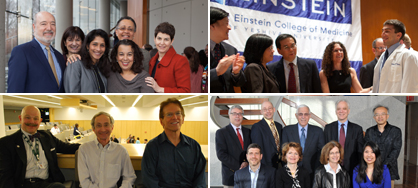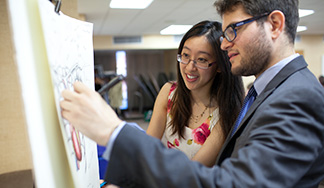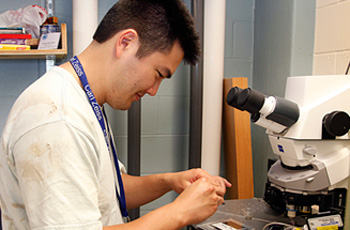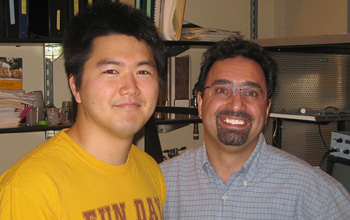

Exploring Brain Function
MSTP Student Sung-Min Park Homes in on How Our Brains Work
When you reach for your coffee cup, you’re pretty sure you’ll be able to pick it up and take a sip. Most likely, you count on being able to do it again and again and again.
Of course, executing even simple moves is more complicated than it feels. In order to perform this or any other action, multiple neurons must signal your muscles to carry out the task.
But how, exactly, does the activity of many neurons translate into precise movement?

Sung-Min Park in the MBL laboratory where he conducted his researchSung-Min Park spent the summer trying to find out. In August, Mr. Park — who will graduate with both M.D. and Ph.D. degrees from Einstein’s Medical Scientist Training program in 2013 — completed a Grass Foundation Fellowship in which he attempted to answer the question: "Is Neuronal Averaging Possible?" Grass Foundation Fellowships enable early-stage investigators planning careers in neuroscience to carry out independent research projects at the Marine Biological Laboratory (MBL) in Woods Hole, Massachusetts.
Simply put, Mr. Park wanted to find out how single neurons in the cerebellum (the part of the brain that coordinates physical movement) could ‘listen’ to the electrical activity of lots of other neurons, and translate it into a signal for precise motor movement.
“Sung-Min was addressing one of the most fundamental questions in neuroscience,” said his Einstein mentor, Dr. Kamran Khodakhah, professor of neuroscience. “While our physical movements are quite precise, individual neurons signal variably.”
Born and raised in Hawaii, in a family of academics, Mr. Park knew early on where his interests lay. “The brain always fascinated me,” he said. “In college I fell in love with neuroscience. I’m interested in how we humans became such sophisticated computers.”
For his project, Mr. Park worked from a hypothesis asserting that the brain could average signals the way we average a pool of numbers. Although scientists have suspected as much for decades, “No one had actually shown that each neuron is capable of averaging information to provide an accurate signal,” said Dr. Khodakhah.
While viewing individual rat neurons under a microscope, Mr. Park attached tiny electrodes to the cells and recorded the electrical voltage. The resulting data was transmitted to a computerized device that created a read-out similar to an EKG. “Looking at it, we could see whether the output signals were the average of the input signals,” he explained.
After running many trials on each of the rat neurons at his disposal, Mr. Park’s data strongly suggested that the neurons could, in fact, average. It is, he said, “a definite possibility.”

Sung-Min with his Einstein mentor, Dr. Kamran Khodakhah“The next step might be to find out under which conditions neurons can do this in the nervous system, and where, as this is particularly important,” suggested Dr. Felix Schweizer, co-director of the Grass Fellowship Program.
Mr. Park agreed, noting that in the future, neuronal averaging might be put to clinical use in a number of ways. For example, knowing that individual brain cells are capable of such sophisticated calculation could support the current theories behind brain machine interface technology — devices that enable a person’s neuronal activity to control prosthetic limbs and other assistive devices. Understanding how nervous systems reduce the electrical “noise” in individual neurons also might be helpful in understanding motor disorders, such as ataxia.
During his 14-week research stint at the MBL, he worked closely with six other Grass Fellows and the directors of the program, who were very helpful. They assisted him in setting up computer codes and offered suggestions on how to modify his experiments and analyze the results.
Dr. Schweizer, who played a role in selecting Grass Fellows this year, observed, “Sung-Min proposed a concise project that was feasible in the time allotted. Also, his project was exciting and he had the wherewithal to do it.”
When Mr. Park completes the M.D.-Ph.D. program at Einstein in 2013, he hopes to do research and clinical work in neurology, psychiatry or rehabilitative medicine. But for now, he’s satisfied to have gained a better understanding of the building blocks of life.
He noted, “The most important thing I’ve learned is how incredibly complex a single cell can be — and how much electrical and molecular computation a single cell can do.”
Note: Grass Fellowships are open to students who are currently working on or have recently completed their Ph.D.s. For more information, visit the Grass Foundation online at www.grassfoundation.org.
Posted on: Thursday, October 6, 2011


